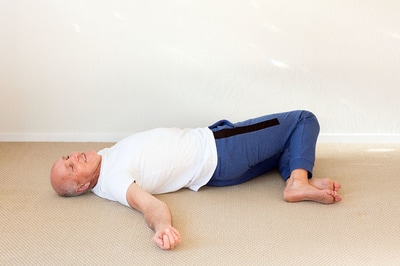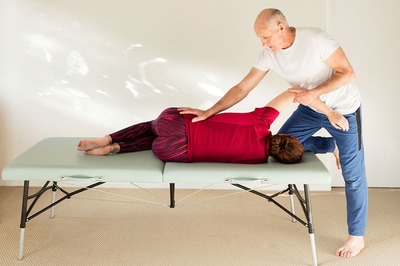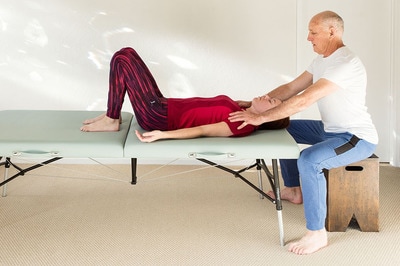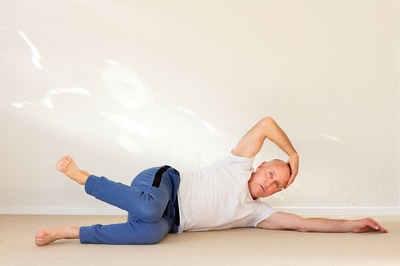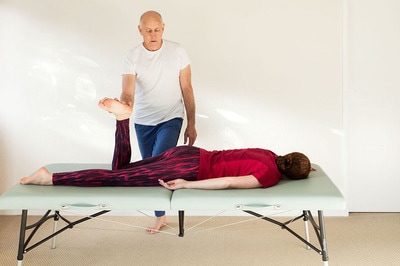What is Somatic Movement Education?
Somatic Movement Education is a neurological based movement programme. Habitually held tight muscles cause many of the aches and pains, fatigue and restriction of movement that we experience. Somatic Movement Education involves our nervous system in re-educating the brain to relax these chronic tight muscles allowing the body to once again move freely with ease and comfort.
How do muscles become chronically tight?
Everything we do in life involves movement and the brain our control centre directs all this movement. Even reading this involves the brain directing our eyes to move. When we move the muscles contract to allow this to happen and when the movement is finished these muscles should completely relax. However because of the stresses of life the muscles don’t always return to their natural resting state. There are many different stresses that can impact on us in different ways. For example people who are very busy often hold their back muscles tight all the time, they are always quickly moving on to the next task and forget to relax these muscles. Our back muscles are very useful as they are our action muscles moving us forward in life to explore and make things. But if the muscles never relax completely the brain receives a sensory message that this is a new normal and actually forgets where fully relaxed is. We now have a sway back, a habitually held postural position and this is where it stays leading to all sorts of back pain issues. The muscles are perhaps only 90% relaxed and are now being held in a 10% contraction of chronic muscular tension and we don’t even realise this. This is what Thomas Hanna calls Sensory Motor Amnesia and it happens to all of us. This leads to stiffness, discomfort, aches and pain, immobility, imbalances in our systems and it uses up energy all day long making us tired.
Another example of these stresses is if you cut your foot. Your brain will arrange your system so as to protect the foot with your weight shifting into the opposite leg. The waist muscles will tighten, the pelvis will tilt and rotate and you will develop a limp. If this wound takes a while to heal this may become a held pattern, a new habit, a reflex to protect the foot. The brain has actually developed a new neural pathway to the muscles which takes over from its previous one. When the cut has healed you still remain with the protective reflex. You now have an imbalance that can put pressure on the knee joint and over a period of time you develop knee pain. The problem seems to be at the knee but the cause is up at the waist and pelvis area and until the muscles there are released no amount of attention to the knee will sort it.
These are two examples of habitually held postural positions that Thomas Hanna recognised as naturally occurring reflexes in our systems that lead to many of our issues. They are known as the Landau reflex and the Trauma reflex and there is another one, the Startle reflex which relates to the muscles of the front of the body.
Everything we do in life involves movement and the brain our control centre directs all this movement. Even reading this involves the brain directing our eyes to move. When we move the muscles contract to allow this to happen and when the movement is finished these muscles should completely relax. However because of the stresses of life the muscles don’t always return to their natural resting state. There are many different stresses that can impact on us in different ways. For example people who are very busy often hold their back muscles tight all the time, they are always quickly moving on to the next task and forget to relax these muscles. Our back muscles are very useful as they are our action muscles moving us forward in life to explore and make things. But if the muscles never relax completely the brain receives a sensory message that this is a new normal and actually forgets where fully relaxed is. We now have a sway back, a habitually held postural position and this is where it stays leading to all sorts of back pain issues. The muscles are perhaps only 90% relaxed and are now being held in a 10% contraction of chronic muscular tension and we don’t even realise this. This is what Thomas Hanna calls Sensory Motor Amnesia and it happens to all of us. This leads to stiffness, discomfort, aches and pain, immobility, imbalances in our systems and it uses up energy all day long making us tired.
Another example of these stresses is if you cut your foot. Your brain will arrange your system so as to protect the foot with your weight shifting into the opposite leg. The waist muscles will tighten, the pelvis will tilt and rotate and you will develop a limp. If this wound takes a while to heal this may become a held pattern, a new habit, a reflex to protect the foot. The brain has actually developed a new neural pathway to the muscles which takes over from its previous one. When the cut has healed you still remain with the protective reflex. You now have an imbalance that can put pressure on the knee joint and over a period of time you develop knee pain. The problem seems to be at the knee but the cause is up at the waist and pelvis area and until the muscles there are released no amount of attention to the knee will sort it.
These are two examples of habitually held postural positions that Thomas Hanna recognised as naturally occurring reflexes in our systems that lead to many of our issues. They are known as the Landau reflex and the Trauma reflex and there is another one, the Startle reflex which relates to the muscles of the front of the body.
How do you release this chronic muscular tension?
In a Clinical Somatic Movement Education session you will be guided to move your sensory motor amnesia into sensory motor awareness. You will be taught a specific technique called a Pandiculation, to carry out simple movements which release and lengthen your muscles. You will be asked to “pay attention” to the sensations that happen as you do the movements. This awareness is what enables you to be able to control your muscles and restore optimum function to your body. You will be engaging your brain to teach you to release the muscles. Once the tension has been released you will be taught a self-care programme of safe gentle movements and be encouraged to practice these regularly helping you to maintain and improve your sensory motor awareness and consequently your quality of life. This is not physical exercise as we normally think of it, this is sensory motor training. Training designed to help you function better so you are able to participate with more ease and comfort in all the activities of your daily work and lifestyle and to do this late into your life.
"If you don't look after your own body where are you going to live?"
